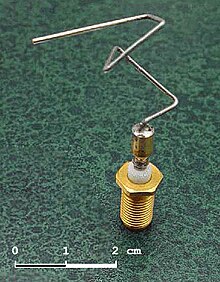Evolved antenna

In
Process
The computer program starts with simple antenna shapes, then adds or modifies elements in a semirandom manner to create a number of new candidate antenna shapes. These are then evaluated to determine how well they fulfill the design requirements, and a numerical score is computed for each. Then, in a step similar to natural selection, a portion of the candidate antennas with the worst scores are discarded, leaving a smaller population of the highest-scoring designs. Using these antennas, the computer repeats the procedure, generating a successive population (using operators such as mutation, crossover, and selection) from which the higher-scoring designs are selected. After a number of iterations, the population of antennas is evaluated and the highest-scoring design is chosen. The resulting antenna often outperforms the best manual designs, because it has a complicated asymmetric shape that could not have been found with traditional manual design methods.
The first evolved antenna designs appeared in the mid-1990s from the work of Michielssen, Altshuler, Linden, Haupt, and Rahmat-Samii. Most practitioners use the genetic algorithm technique or some variant thereof to evolve antenna designs.
An example of an evolved antenna is an
References
- ^ Hornby, Gregory S.; Al Globus; Derek S. Linden; Jason D. Lohn (September 2006). "Automated antenna design with evolutionary algorithms" (PDF). Space. American Institute of Aeronautics and Astronautics. Retrieved 2012-02-19.
- ^ Kuroda, Vanessa; Mark Allard; Brian Lewis; Michael Lindsay (August 2014). "Comm for Small Sats: The Lunar Atmosphere and Dust Environment Explorer (LADEE) Communications Subsystem". 28th Annual AIAA/USU Conference on Small Satellites. Retrieved 2020-10-27.
External links
- [1] at NASA Ames Research Center
- A paper given by Lohn, Hornby, and Linden at the Genetic Programming Theory Practice 2004 Workshop.
